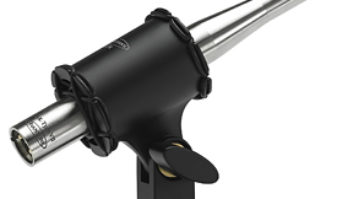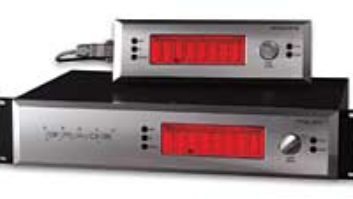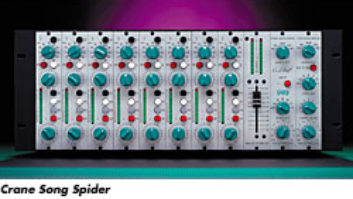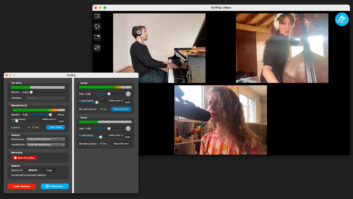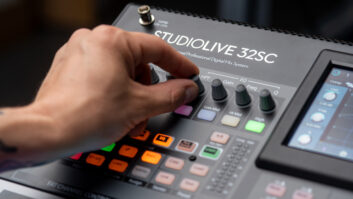The Aphex 1788 is a full-featured, 8-channel, remotely-controllable microphone preamplifier offering excellent sound quality plus two inventions: continuously variable gain control without “zippering” noise and a peak limiter that offers additional dynamic range without clipping the preamp’s input.
In addition to 26 to 65 dB of variable gain, a 26dB pad, polarity reverse, a 75Hz low-cut filter and 12-segment LED headroom meter, each channel includes a unique microphone limiter (MicLim[superscript]TM) before the preamp, preventing clipping altogether and allowing higher gain settings. The main and auxiliary outputs are individually adjustable to match the limiter’s operation to the input headroom of connected analog devices. The limiter also assures that the optional digital outputs never hit ‘Over.’
All controls can be accessed from the front panel. Channels can be grouped to adjust the parameters or gain of several at once. A headphone amp allows local monitoring. A 700Hz test tone at either -20 or 0 dBfs can be assigned to any channel.
Remote control of up to 16 units (128 channels) can be handled with a single MIDI, RS-232 or RS-422 control line via MIDI protocol. The controller can be anything that talks MIDI or a personal computer. An optional dedicated remote controller, the 1788-R, duplicates the front panel controls and adds clip/limit indication and device selection for 16 units, as well as preset loading and editing. Multiple 1788-Rs can be used in serial with or without a PC, allowing control from various remote locations.
1788 Program Software for Windows 95 is included, providing screens for control and status, or saving and recalling scenes. Its main window duplicates the front panel’s control and metering for each device, including grouping functions. In addition to real-time metering, the software displays either peak-hold or absolute maximum levels, updated every half second. It allows up to 20 scene changes, each linked to presets that are named in software, and each snapshot is a MIDI dump containing all device parameters. As the preamps offer glitchless gain changes, scenes are smoothly ramped without muting. The System Setup window is an alternative to the master window that simplifies comparing the settings or programming multiple units. All settings of four 1788s, including channel and device names, can be seen at once, and for larger systems this window scrolls.
Each channel has two independently adjustable balanced outputs. A digital option-24-bit sampled at 32, 44.1 or 48kHz-has three outputs simultaneously: AES/EBU, ADAT optical and TDIF. Connections are eight XLR inputs, eight XLR outputs and DB-25 (Tascam) for the auxiliary outputs. The digital option has AES/EBU on a DB-15, ADAT optical, TDIF on DB-25 and Word Clock in/out on BNCs.
The 1788 is a cost-effective solution for touring acts that want to record their shows as it offers direct digital connection to recorders while the main out is connected to the FOH and the Aux out routed to the monitors. It can substitute for conventional passive splits and offers enhancement over active splits. Placing the preamp closer to the microphone reduces mode noise because gain does not have to be taken at the end of the run. Frequency response effects of capacitance in long mic lines are reduced. Also, loading a mic into a single preamp allows higher quality than loading that mic into several preamps through a splitter. Remote control allows use of fiber systems without an engineer babysitting the preamps.
An internal jumper allows users to “unload” this transformer for a more colorful character, though I prefer the honest transparency offered by the factory-default setting. I used it for several vocal applications, from choir mics to handhelds, where the 75Hz highpass was convenient and the mic limiters were a luxury. It was also used on a Pavarotti show for the two Schoeps MK-4 vocal mics, substituting for the usual active splitter, where it offered an open, clear sound, earning compliments from both the artist and the audience. The auxiliary output allowed separate connection to two more channels in the console, used strictly for foldback. It was also used at field level on shotgun mics used at the SuperBowl for crowd ambience.
With the 1788, you will discover new approaches for both live and recorded sound. Listing for $4,995, it costs no more per channel than many high-quality mic pre’s, but adds the double bonus of remote control and preamp limiting. The digital output option is $995.
Aphex Systems, 11068 Randall St., Sun Valley, CA 91352; 818/767-2929; fax 818/767-2641; www.aphexsys.com.
